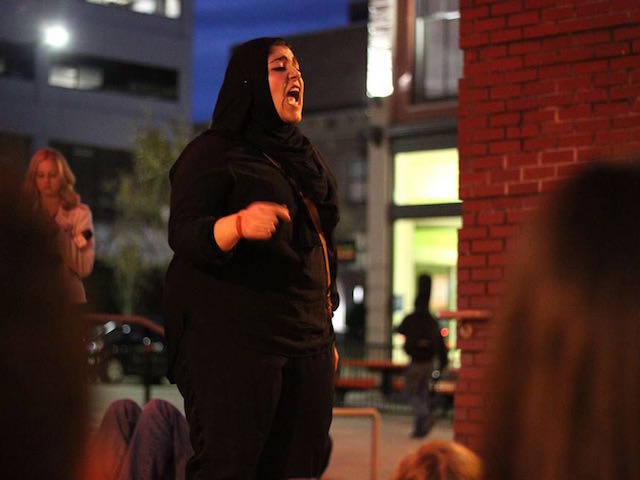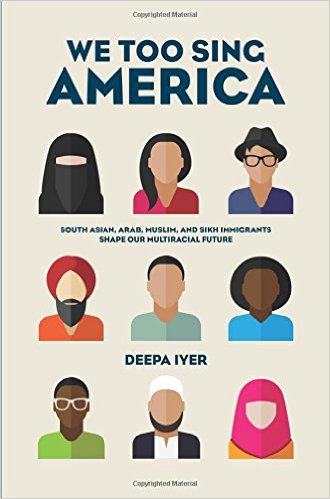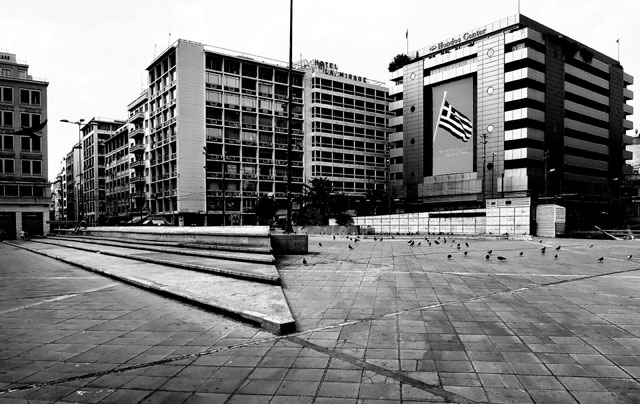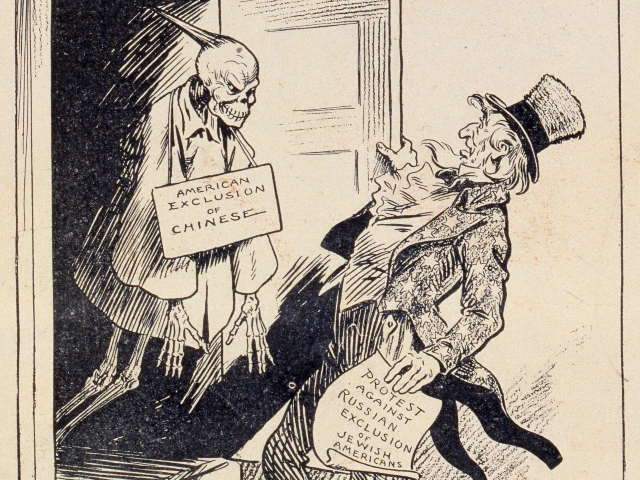As immigrant communities reshape Tennessee’s racial landscape, how the state has become a breeding ground for anti-Muslim sentiment

May 4, 2016
Tomorrow, Thursday, May 5, come see Deepa Iyer in conversation with YaliniDream, Hina Shamsi, and Aber Kawas at AAWW’s event Intro to Islamophobia and Xenophobia.
* * *
On June 4, 2013, twenty-two-year-old Drost Kokoye drove from her home in Nashville to Manchester, Tennessee, with three other Muslim activists, Remziya Suleyman, Mohamed Shukri, and Zulfat Suara to attend a community forum organized by the American Muslim Advisory Council (AMAC). Drost and her colleagues were deeply involved with grassroots efforts to address the wave of anti-immigrant, anti-refugee, and anti-Muslim sentiment that had taken hold in parts of Tennessee since 2010. Drost and Remziya worked for an American Muslim grassroots organization called the American Center for Outreach, and Mohamed and Zulfat were affiliated with AMAC.
On their drive, the four activists discussed the distinct possibility of encountering protests at the Manchester community forum. In fact, just a few weeks earlier, Barry West, the commissioner of Coffee County, where Manchester is located, had posted on Facebook a picture of a white man in a cowboy hat pointing a gun. West called the post “How to Wink at a Muslim.” When asked about the picture, West responded: “I’m prejudiced against anyone who’s trying to tear down this country, Muslims, Mexicans, anybody . . . If you come into this country illegally or harm us or take away benefits, I’m against it.” West’s remarks made his opinions on who is the “us” and who is the “other” in Tennessee quite clear.
West’s comments did not occur in a vacuum, however. Over the previous three years, parts of middle Tennessee had become a breeding ground for Islamophobia and anti-immigrant rhetoric. That is why AMAC had organized the community forum in Manchester. The forum, open to all residents, provided an opportunity for Muslim leaders to share basic information about Islam and American Muslims and to hear about civil rights protections from representatives of the U.S. Attorney’s Office.
While Drost, Remziya, Mohamed, and Zulfat were prepared to face opposition from anti-Muslim spokespersons and organizations at the forum, they had no idea about the extent of it until they arrived. “We didn’t expect it to be four hundred people,” Drost remembered. “Outside the location, there was a sort of pep rally going on. Pam Geller had been speaking to the crowd, riling people up.” Geller is a prominent figure who promotes Islamophobia in the United States. She is the co-founder of groups such as the American Freedom Defense Initiative and Stop Islamization of America, which have been listed on the Southern Poverty Law Center’s map of hate groups.
Geller often frames her messages of intolerance of Muslims by claiming that she has a right to free speech. While this appeals to one aspect of core American values, Geller’s incendiary rhetoric diminishes our equally cherished ideals of religious freedom, respect, and plurality. At the “pep rally” outside the Manchester forum, for example, Geller fueled fears of Muslim radicalization and encouraged the crowd to speak out against the “most brutal and oppressive ideology on the planet.” The crowd responded with cheers and applause.
When the forum started, nearly five hundred people packed the room. It turned out that many had been brought in from other parts of Tennessee or the South. Drost and her colleagues sat in the first row. One of the Muslim speakers, Sabina Mohyuddin, provided a basic overview of Islam with information about the long history of Muslims in the United States and the community’s beliefs in prayer, charity, and peace. But she was interrupted consistently from the audience with racial and religious slurs.
“We hadn’t seen anything like this before,” Drost recalled. “Even when U.S. Attorney Bill Killian began his remarks about civil rights, the audience wouldn’t let him speak. They shouted and booed him. They had no respect.” When Zak Mohyuddin, a Bangladeshi American who had resided in Coffee County for twenty-five years, addressed the crowd, people shouted, “Speak English!” and “Go Home!” Drost was most shocked by the crowd’s response to seeing pictures of mosques that had been firebombed and vandalized in recent years in different parts of Tennessee. “When the crowd saw these pictures, they actually applauded and cheered,” Drost said. “They believed that these incidents were positive ones, that they should actually happen in our state.”
As the forum proceeded, Drost began to feel increasingly uncomfortable and unsafe in her front-row seat. At one point, a woman sitting behind her spat at Drost and muttered anti-Muslim slurs. During the question-and-answer portion of the forum, when Drost rose to pass out index cards to the audience, a man shouted, “Watch out, she might blow up!” The crowd laughed in response.
These experiences at the Manchester forum motivated Drost and her colleagues to redouble their efforts to address intolerance and bigotry in their home state. But they also knew that they faced an uphill battle in parts of Tennessee, where socially conservative policies and beliefs continue to wield influence, even as immigrant communities are reshaping the state’s racial landscape.
The demographic changes in Tennessee are striking. One in sixteen Tennesseans is either Latino or Asian, and they wield increasing economic and political power in the state. In 2012, the purchasing power of Latinos and Asians was $6.1 billion and $4.8 billion, respectively. In addition, the children of immigrants in Tennessee are poised to become a strong electoral bloc in decades to come. According to the urban institute, 89 percent of children in Asian families and 87 percent of children in Latino families were U.S. citizens in 2009, meaning that they are on their way to becoming voters.
The city of Nashville has witnessed the most dramatic demographic changes in Tennessee. Between 2000 and 2012, the city’s foreign-born population grew 86 percent, compared with an 11 percent increase in the native-born population. In 2012, Nashville had the fastest-growing immigrant population of any city in America, as increasing numbers of Burmese, Kurdish, Somali, and Sudanese immigrants and refugees began to call it home.
They followed in the footsteps of Chinese, Indian, and Latino communities who had moved to the city in earlier decades. On Nolensville Pike, which has become an immigrant hub, a building called Casa Azafrán stands as a testament to these diverse communities. It houses organizations such as the American Center for Outreach, the Tennessee Immigrant and Refugee Rights Coalition, and Conexión Américas, all of whom work with the booming immigrant and refugee populations in the Nashville metropolitan area.
Drost and her family are part of this wave of newcomers who have made Nashville their home. Originally from Kurdistan, the Kokoye family arrived in the United States in 1997 as refugees escaping political persecution in Iraq. Drost explained that U.S. Military Forces had recruited her parents to assist with efforts to overthrow the Iraqi government, an experience not uncommon for many Kurds. When the Iraqi government discovered that Drost’s father was assisting the American government, the family knew that their lives were in danger. U.S. forces quickly moved them out of the area. Drost and her family first traveled to refugee camps in Turkey. There they were approved for refugee status by the U.S. Government for demonstrating that if they were to return to Iraq, they feared persecution due to their religion, nationality, or political opinion. They traveled next to Guam and then were finally resettled in Phoenix, Arizona. As refugees, Drost’s family received medical and cash assistance from the federal government for a limited period of time to help them settle into their new country.
After ten months in Phoenix, Drost’s parents decided to move to Nashville, which had become home to the largest Kurdish population in the United States. An estimated eleven thousand to thirteen thousand Kurds live there. On Nashville’s south side, in an area near Nolensville Pike and Elysian Fields Road, sit Kurdish bakery shops, a food market, and a mosque called the Salahadeen Center of Nashville. But the wider community did not easily accept Kurdish refugees. Drost remembered that her adolescent and teenage years were marked with outsider status as a refugee. “In Iraq, we were seen as helpful allies to the United States, but once you [were] here, people saw you as a charity case needlessly receiving federal money and wondered why you were here in the first place,” she told me.
After 9/11, Drost realized that she was being treated as a “double other”—a refugee and a Muslim. “It went from us being refugees getting free handouts to us now being a danger to the community. At this point, we became the threat. We became the ones that people run away from all of a sudden.” Growing up as a refugee and a Muslim in post-9/11 America can be a difficult experience altogether, but navigating those identities in the U.S. South presented unique challenges for Drost. “You never escape the Bible Belt, even in any social setting,” she said. “So, for our community and the kids, it’s balancing that and not feeling ashamed or guilty about your faith and identity. When all you see is the news condemning what you believe, you start to want to run away from it as well.” But Drost did just the opposite. Along with other activists and community leaders, she directly responded to the wave of anti-Muslim sentiment spreading throughout parts of Tennessee.
In February 2008, Eric Ian Baker and two others vandalized and burned down the Islamic Center in Columbia, Tennessee, using Molotov cocktail explosion devices. They also painted swastikas and the phrase “White Power” on the mosque. In 2010, the Alfarooq Islamic Center, attended mainly by Somalis in Nashville, was vandalized with the words “Muslims Go Home.” When area mosques came together to create a rapid-response team to address the growing incidents of vandalism and property destruction, Drost became involved as well.
In the fall of 2010, Drost enrolled as a sophomore at Middle Tennessee State University in Murfreesboro. She would soon become part of local efforts to address one of the most publicized anti-mosque campaigns and examples of religious bigotry in the history of our nation.

Tomorrow, May 5, come hear Deepa Iyer talk about the battle over building a mosque in Murfreesboro, TN, and the research for her new book, We Too Sing America: South Asian, Arab, Muslim, and Sikh Immigrants Shape Our Multicultural Future (The New Press), alongside YaliniDream, Hina Shamsi, Aber Kawas.
Copyright © 2015 by Deepa Iyer. This excerpt originally appeared in We Too Sing America: South Asian, Arab, Muslim, and Sikh Immigrants Shape Our Multicultural Future, published by The New Press. Reprinted here with permission.



